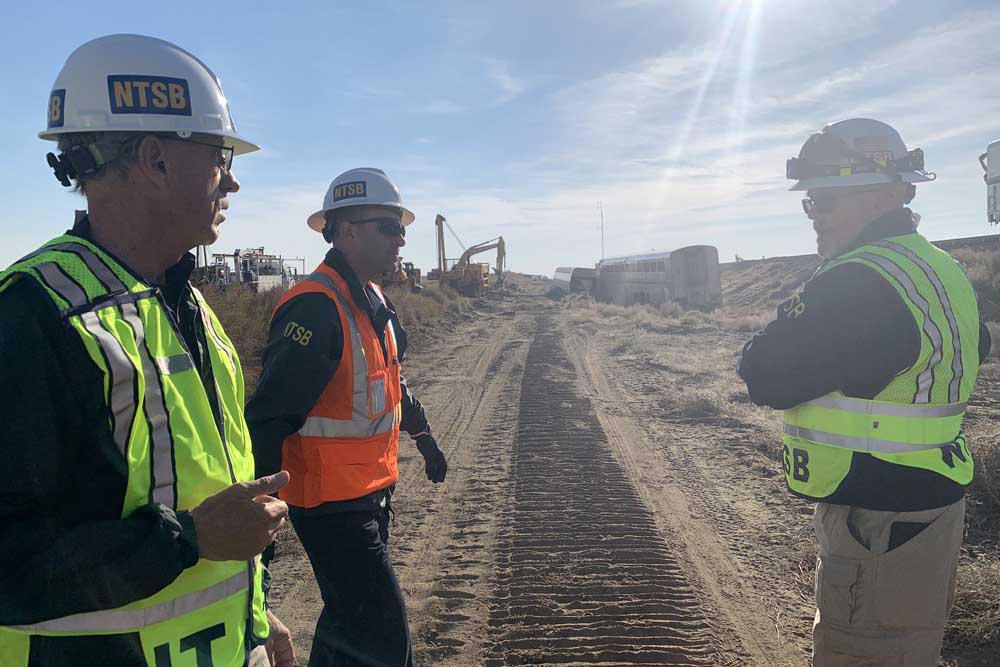
GREAT FALLS, Mont. — An Amtrak on-board service attendant injured in September’s derailment of the Empire Builder has become the latest to file suit over the accident.
The Billings Gazette reports Tarrick Peyton filed suit in U.S. District Court in Great Falls against Amtrak and BNSF Railway for negligence in the Sept. 25 accident that killed three people. The suit claims negligence in causing the accident, not discovering a track defect, not operating the train safely, and not providing the training and tools to respond to the derailment.
The suit alleges Peyton’s three weeks of training before starting work in August 2021 did not address what to do in the event of a derailment or how to help surviving passengers and crew.
Peyton’s suit says he found the bodies of all three of the people killed in the accident, as well as others who were injured. After an hour of helping passengers, he said he was exhausted, in pain, and vomiting, and was sent to the hospital by an emergency medical technician. The suit says he has been diagnosed with head and shoulder injuries; injuries to the discs, nerves, and connective tissue in his lower back; and Post-Traumatic Stress Disorder. As a result, he has suffered economic losses and experienced pain and suffering and will continue to do so, the suit says.
An Amtrak spokesman told the newspaper the company is aware of the suit and will “review and respond in the appropriate channels.” BNSF declined comment.














Rausch: I am confused. Seems the total of your comment is applicable to the “Peyton lawsuit”. But you stated “Obviously, employees experiencing injuries or death due to employers negligence are not required to do anything.” This is not obvious to me.
Maybe I am confused again on this point: Was this the flawed track that was checked for such and it showed a border line flaw? It is routine to stop the inspection and check manually at different angles to make sure, but that was not done. That ONLY applies to the Peyton claim of flawed track. If what I said above is true (track inspection failure), I guess then BNSF would have to sue Sperry. In the past I have noticed when people sue, they include mom, dad, sister-in-law, 5th grade teacher but in this case Sperry wasn’t mentioned.
That Sperry inspection supervisor (even if Peyton lawsuit is another rail fault incident, there was an improper inspection somewhere else). In the case of the Mississippi River bridge on I-40 recently, that inspector lost his job. Interesting too. 5 years before the actual alarm of a crack, a canoeist on the river took a picture of the crack under the bridge . This picture was given to ARDOT. Nothing came of the warning. Kinda like the Sperry supervisor not doing a thorough job. So much for being a good citizen and trying to help out.
I’m not an attorney nor a legal expert by any means, but I understand that FELA, the Federal Employers Liability Act, is applicable for railroad employees instead of Worker’s Compensation. However, I believe in either case, in some or many situations of injury, sickness or death, an attorney specializing in FELA or WC is at least consulted and then employed to negotiate the settlement. Obviously, employees experiencing injuries or death due to employers negligence are not required to do anything. It is also my understanding that an employee experiencing lesser injuries routinely reaches a settlement with the carrier (the railroad) sometimes while continuing to work or sometimes returning to work after.
above #2.Charles Powell says:……For a fact, true. I have a personal friend who is signal maintainer for BNSF. He was treated monetarily and sufficiently to his satisfaction. He has no complaint after his injury.
Have they unwittingly let the cat out of the bag, re a “track defect” ???.
Even when there is insurance an injured person often has to sue to get full coverage. Insurance companies do not make money by paying claims.
Railroad employees are NOT covered by workmen’s compensation insurance. Virtually all other workers are covered by their employer. Comp pays the hospital, rehab and disability claims.
Railroad workers, to obtain compensation for work-related injuries must sue their employers to obtain compensation. The same is true for domestic seamen.
I did not know that. On the flip side, does Amtrak and the railroads inform new hires that they are not covered by Worker’s Comp, and therefore they should either set something aside for a “rainy day”, or decline to accept the job and the risk? Conversely, do the railroads pay “more” to partially offset the risk? I suspect, not. Perhaps in the current tight labor market, the railroads would want to offer the fringe benefit?
I beg to differ that railroad workers must sue to obtain compensation. I was a Class 1 worker who got hurt on the job; the company paid all of my medical bills and gave me a small sum for inconveniences.